In the guide
To fully understand this guidance, it is important to note the difference between the United Kingdom and Great Britain:
- UK: England, Scotland, Wales and Northern Ireland
- GB: England, Scotland and Wales
In this guide, the words 'must' or 'must not' are used where there is a legal requirement to do (or not do) something. The word 'should' is used where there is established legal guidance or best practice that is likely to help you avoid breaking the law.
This guidance is for England
When animals are to be exported, all relevant persons must ensure that they are correctly identified, in good health and accompanied by the correct documentation. There are also documentation requirements for germplasm and germinal products.
Ban on the export of livestock for fattening or slaughter
You cannot export live animals (cattle, sheep, pigs, goats or horses) for slaughter or fattening for slaughter. This ban applies to journeys from or through Great Britain to anywhere outside the UK, Channel Islands or Isle of Man.
You can still export live animals for other purposes - for example, for breeding and competitions.
Back to topDocument requirements
An export health certificate (EHC) is required for germplasm / germinal products (semen, ova and embryos), live animals and products of animal origin (POAO) when undertaking the following activities:
- moving them through the EU and Northern Ireland (NI)
- exporting them from GB to EU
- moving them from GB to NI
An EHC is an official document that is signed by either an official veterinary surgeon or an authorised local authority officer. It confirms that the export meets the destination country's health requirements. Each different type of product will require a separate EHC. Additional transit EHCs may be required by each country the export moves through. An EHC is needed to move animals from GB to NI because of the Northern Ireland Protocol, which came into force on 1 January 2021.
See the GOV.UK website for more details on applying for an export health certificate.
Evidence of an annual animal health veterinary visit is required for livestock that is to be exported. This can be achieved via veterinary attestation, a template is provided on the GOV.UK website.
Customs declarations will also be required and must be made via the Customs Declaration Service (CDS), which is a database reporting system that enables records to be kept of the movement of goods by sea, air and land.
A journey log is a separate document that must accompany the consignment of farm livestock and unregistered horses (see below for more information on horses). This is in addition to all the other required documentation. Journey logs contain details such as the plan for the journey, place of departure, destination and transporter declaration.
Poultry export can only be undertaken by members of the Poultry Health Scheme (PHS), unless exporting fewer than 20 birds or hatching eggs to the EU or NI. Some non-EU countries require PHS membership; exporters should check the EHC for details.
Back to topIdentification requirements for livestock destined for export
Sheep and goats
Sheep and goats are subject to the same rules.
For animals that are already double tagged with UK tags (one of which must be the mandatory yellow electronic identification (EID) tag) you can add a third tag with the GB prefix.
For example:
- existing tags: UK0123456 00001
- third tag: GB0123456 00001
Double-tagged animals must have one tag in each ear and the third can go in either. Third tags must not be yellow or red. Lost or damaged tags can be replaced with tags bearing the GB prefix.
Single-tagged animals must be re-identified using double tags before being exported or moved to the EU or NI.
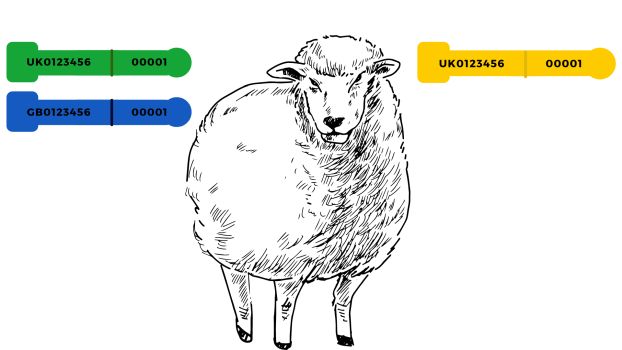
For unidentified animals being tagged for the first time, you should use double UK tags with the GB suffix - for example, UK0123456 00001 GB. One of these must be the mandatory yellow EID tag.
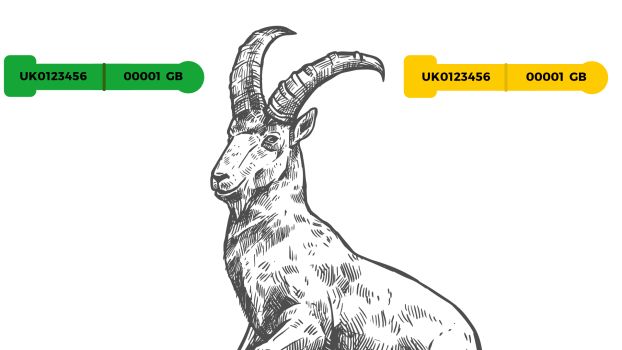
All tags must include the animal's individual ID number.
Cattle
For those cattle that are already tagged with UK tags, you can add a third 'management' tag that has a GB prefix followed by the animal's ID number. The third GB tag can be a plastic flag-style tag or button tag of any colour.
For example:
- existing tags: UK 111111 123456
- third tag: GB 111111 123456
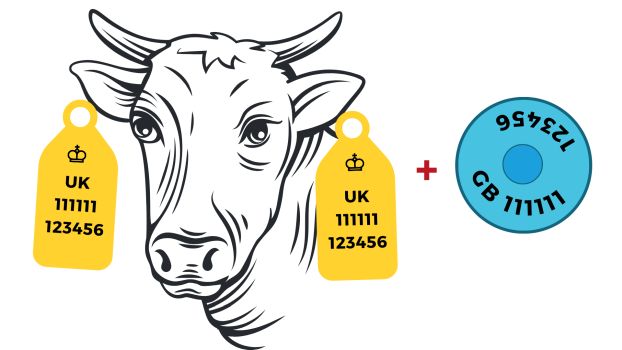
For unidentified calves tagged for the first time, you can add double UK tags, one of which must have a GB suffix. These are primary and secondary tags, one in each ear. The secondary tag has the GB suffix.
For example:
- primary tag: UK 111111 123456
- secondary tag: UK 111111 123456 GB
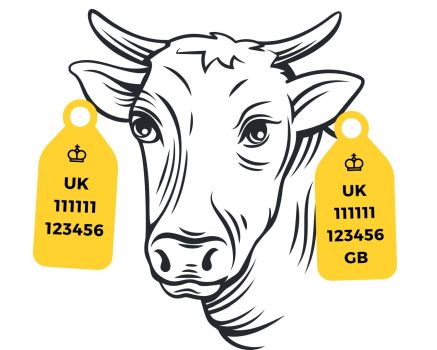
All tags must include the animal's individual ID number. A freeze branded 'L' is required to be applied to the hind quarters of cattle exported for slaughter.
See also the information about registering cattle imported or moved into England or Wales on the GOV.UK website.
Pigs
Pigs must be identified with an ear tag or ear tattoo with a 'UK' prefix, followed by the herd mark of the departure holding and a unique individual identification number - for example, UK XY6789 1234.
Pigs moving to the EU or NI must be identified with an ear tag or tattoo with a 'UK-GB' prefix, followed by the herd mark of the departure holding and a unique individual identification number - for example, UK-GB XY6789 1234.
Exports of pigs must also be reported to the bureau service provided by AHDB Pork within three days of the animal leaving the holding.
Full identification for the pig moved must be recorded as part of the animal movement record.
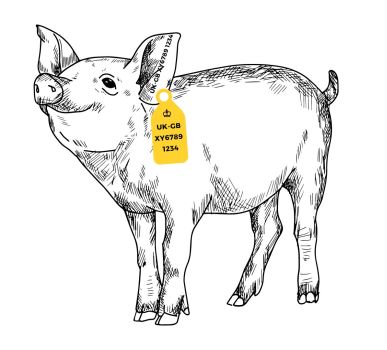
Horses
To export horses (except registered horses*) into the EU from GB, horse owners must have a Government-issued supplementary travel ID from the Animal and Plant Health Agency (APHA), as well as holding a valid passport. The supplementary travel ID, horse passport and export health certificate must remain with the animal during transport.
[*Registered domestic horses are those registered with a recognised breed society or companies like the British Horse Database at Weatherbys. 'Registered domestic Equidae' does not simply mean those with horse passports.]
For information on other export rules and documentation requirements, please refer to the GOV.UK website's guidance on special rules for export horses and ponies.
Back to topAssembly centres
When equidae, bovine, ovine, caprine and porcine animals are to be exported they need to pass through an approved assembly centre. The assembly centres arrange for the animals to be moved to the premises (usually a port or airport) from which they will leave the country.
Back to topPets and non-native species, including zoo residents
You can no longer use a pet passport (for dogs, cats or ferrets) that has been issued in GB for travel to an EU country or NI. You can still use a pet passport issued in an EU country or NI. More information on the requirements when travelling to an EU country or NI with your pet is available on the GOV.UK website.
Different rules apply when travelling to a non-EU country with your pet, including the need for an export health certificate. More information on the requirements for travelling to a non-EU country with your pet is available on the GOV.UK website.
Many zoo and lab animals are subject to the Balai Directive, which covers what is required to move certain animals (and their germplasm) that are not traditional livestock.
Any animal listed by the Convention on International Trade in Endangered Species of Wild Fauna and Flora (CITES) requires a permit or certificate for export. This documentation is also required for movements between GB and NI.
Back to topFurther information
More detailed information on exporting or moving livestock and poultry and transiting animals and animal products through GB can be found on the GOV.UK website. See also GOV.UK's collection of guidance on exporting live animals or animal products.
Back to topTrading Standards
For more information on the work of Trading Standards services - and the possible consequences of not abiding by the law - please see 'Trading Standards: powers, enforcement and penalties'.
Back to topIn this update
Additional requirements related to the Animal Welfare (Livestock Exports) Act 2024 added. The National Export System (NES) has now fully transferred over to the Customs Declaration Service (CDS).
Last reviewed / updated: July 2024
Back to topKey legislation
- Diseases of Poultry (England) Order 2003
- Avian Influenza (Preventive Measures) (England) Regulations 2006
- Cattle Identification Regulations 2007
- Sheep and Goats (Records, Identification and Movement) (England) Order 2009
- Pigs (Records, Identification and Movement) Order 2011
- Non-Commercial Movement of Pet Animals Order 2011
- Animal Welfare (Livestock Exports) Act 2024
Please note
This information is intended for guidance; only the courts can give an authoritative interpretation of the law.
The guide's 'Key legislation' links go to the legislation.gov.uk website. The site usually updates the legislation to include any amendments made to it. However, this is not always the case. Information on all changes made to legislation can be found by following the above links and clicking on the 'More Resources' tab.

